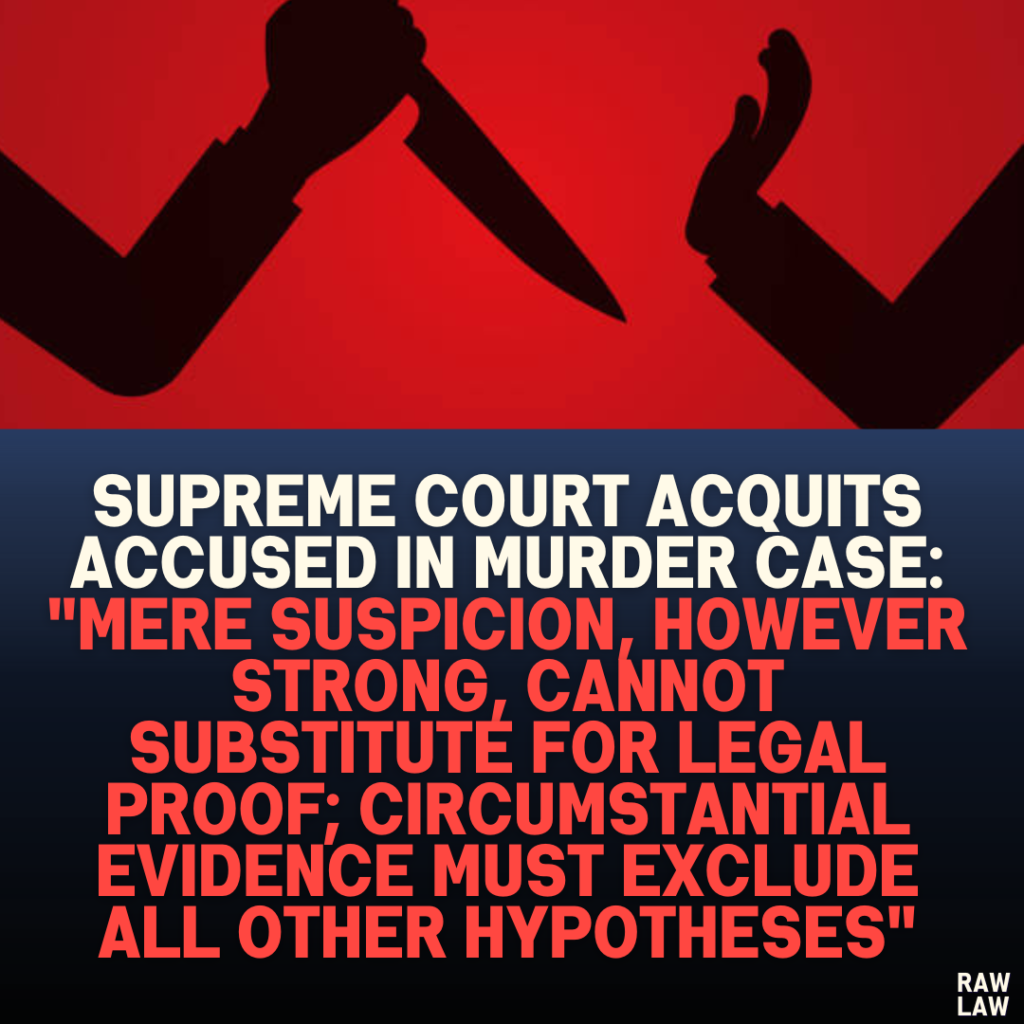Court’s Decision:
The Supreme Court acquitted the appellants of all charges under Sections 302 and 304 Part I of the Indian Penal Code (IPC). The Court found that the prosecution had failed to establish a complete chain of incriminating circumstances linking the appellants to the crime. The conviction by the lower courts was set aside, and the appellants’ bail bonds were discharged.
Facts:
- On 3.2.1997, the body of the deceased was discovered outside a shop in Lohaghat, District Pithoragarh. Multiple ante-mortem injuries were noted on the deceased’s body.
- The postmortem report revealed that the cause of death was shock resulting from head injuries. The injuries included two incised wounds and multiple contusions.
- The accused were arrested on 6.2.1997, with the police alleging the discovery of blood-stained stones based on their statements.
- The prosecution relied entirely on circumstantial evidence, claiming:
- The deceased was last seen alive with the accused.
- The accused were seen near the crime scene at odd hours.
- A black polythene bag with meat recovered near the crime scene was linked to one of the accused.
- The accused had prior enmity with the deceased over panchayat elections.
Issues:
- Did the circumstantial evidence conclusively establish the appellants’ guilt?
- Was the recovery of blood-stained stones credible and linked to the crime?
- Did the accused’s alleged last-seen connection with the deceased provide sufficient grounds for conviction?
Petitioner’s Arguments (Accused):
- The prosecution failed to prove the chain of circumstances beyond reasonable doubt.
- The last-seen evidence lacked proximity to the time and place of the crime.
- The recovery of blood-stained stones was unreliable:
- The forensic report did not confirm the presence of blood on the stones.
- The stones were not conclusively linked to the injuries sustained by the deceased.
- The High Court erred in altering the conviction to Section 304 Part I IPC without evidence justifying the modification.
Respondent’s Arguments (Prosecution):
- The prosecution contended that the chain of circumstances was complete and consistent with the guilt of the appellants.
- The appellants were seen inquiring about the deceased and later walking near the crime scene.
- Blood-stained stones recovered based on the appellants’ statements corroborated their involvement in the crime.
- The motive, coupled with circumstantial evidence, pointed conclusively to the appellants’ guilt.
Analysis of the Law:
The Court reiterated the principles governing circumstantial evidence:
- Circumstances Must Be Fully Established: Each fact relied upon by the prosecution must be proved beyond reasonable doubt.
- Definite Tendency of Circumstances: The facts must unerringly point to the guilt of the accused.
- Complete Chain of Evidence: The circumstances must form an unbroken chain ruling out all other hypotheses except the accused’s guilt.
- Proof Beyond Suspicion: Mere suspicion, however strong, cannot substitute for legal proof.
Precedent Analysis:
The judgment relied on established precedents:
- Sharad Birdhichand Sarda v. State of Maharashtra (1984): Circumstantial evidence must meet stringent requirements to sustain a conviction.
- Devi Lal v. State of Rajasthan (2019): If two interpretations of evidence are possible, the one favoring the accused must be adopted.
- Shivaji Sahabrao Bobade v. State of Maharashtra (1973): A court must distinguish between suspicion and proof, ensuring only definitive conclusions support a conviction.
Court’s Reasoning:
- Last-Seen Evidence: The testimony of a witness (PW-4) who saw the deceased with the accused lacked proximity to the crime. The deceased was last seen alive on 2.2.1997 at 4:30 PM, while the body was found the next morning at 8:30 AM. The significant time gap left room for third-party involvement.
- Recovery of Blood-Stained Stones:
- The forensic report did not confirm the presence of blood on the stones recovered from the alleged crime scene.
- The stones were not shown to the medical examiner to establish a connection with the injuries sustained by the deceased.
- Black Polythene Bag with Meat: The recovery of the bag was not incriminating, as it could not be conclusively linked to the accused. The area had multiple meat vendors, and the bag was not uniquely identifiable.
- Motive: Although the prosecution alleged prior enmity over panchayat elections, no direct evidence of animosity leading to the crime was presented.
- Witness Credibility: Key witnesses delayed reporting their observations, raising doubts about the reliability of their testimony. For instance, one witness reported seeing the accused near the crime scene several days after the incident, despite being present at the initial investigation.
Conclusion:
The Court held that:
- The prosecution failed to prove the chain of circumstances beyond reasonable doubt.
- The evidence presented was insufficient to exclude alternative hypotheses.
- The High Court erred in altering the conviction to Section 304 Part I IPC, as multiple injuries on the deceased indicated a clear intention to kill.
Implications:
This judgment emphasizes the high standard of proof required in cases based on circumstantial evidence. It highlights that:
- All links in the chain of evidence must be conclusively established.
- Courts must remain vigilant against relying on speculative or insufficiently tested evidence.
- Strong suspicion, without corroborative proof, cannot sustain a criminal conviction.
This ruling reinforces the principle that the burden of proof rests squarely on the prosecution to establish guilt beyond reasonable doubt in criminal trials.
